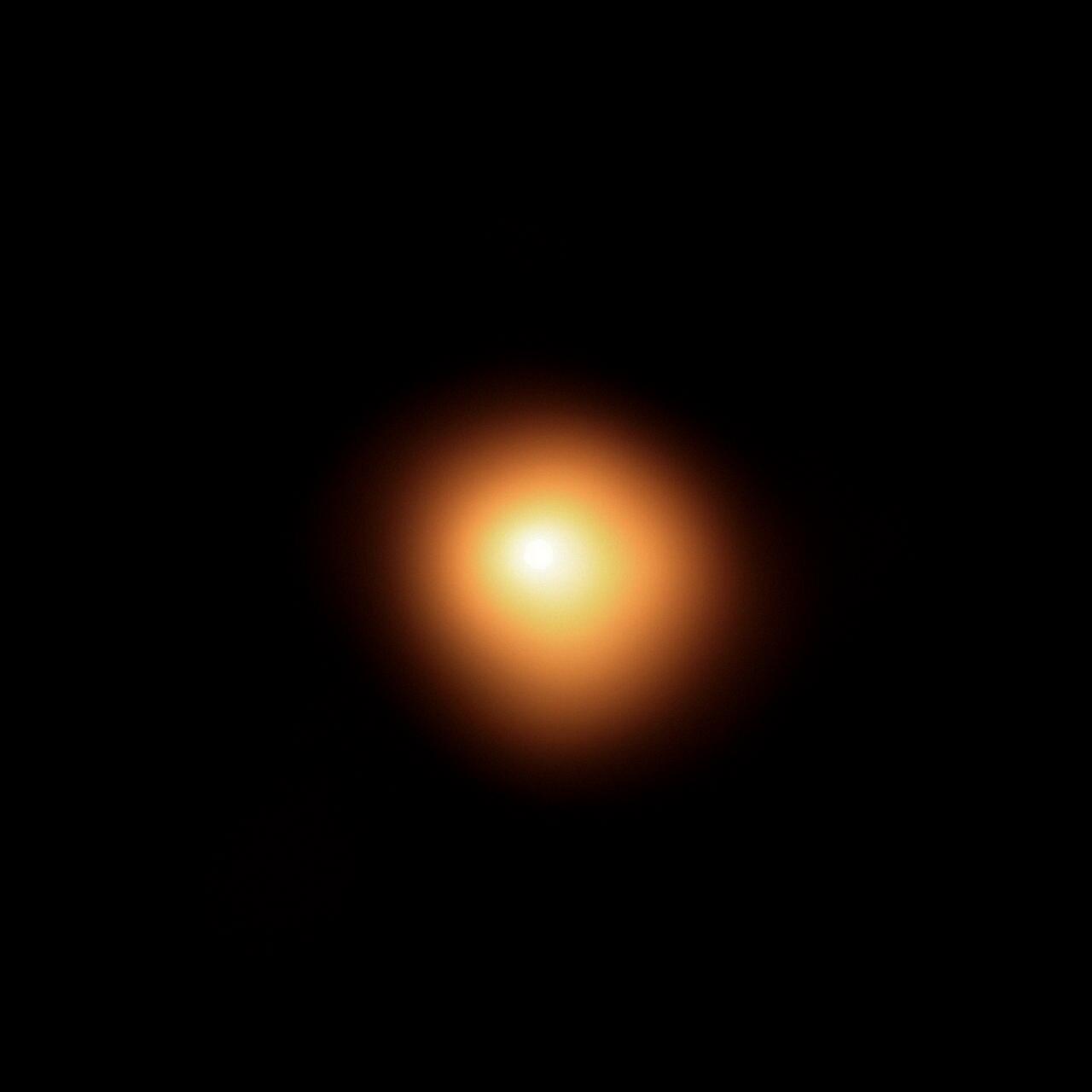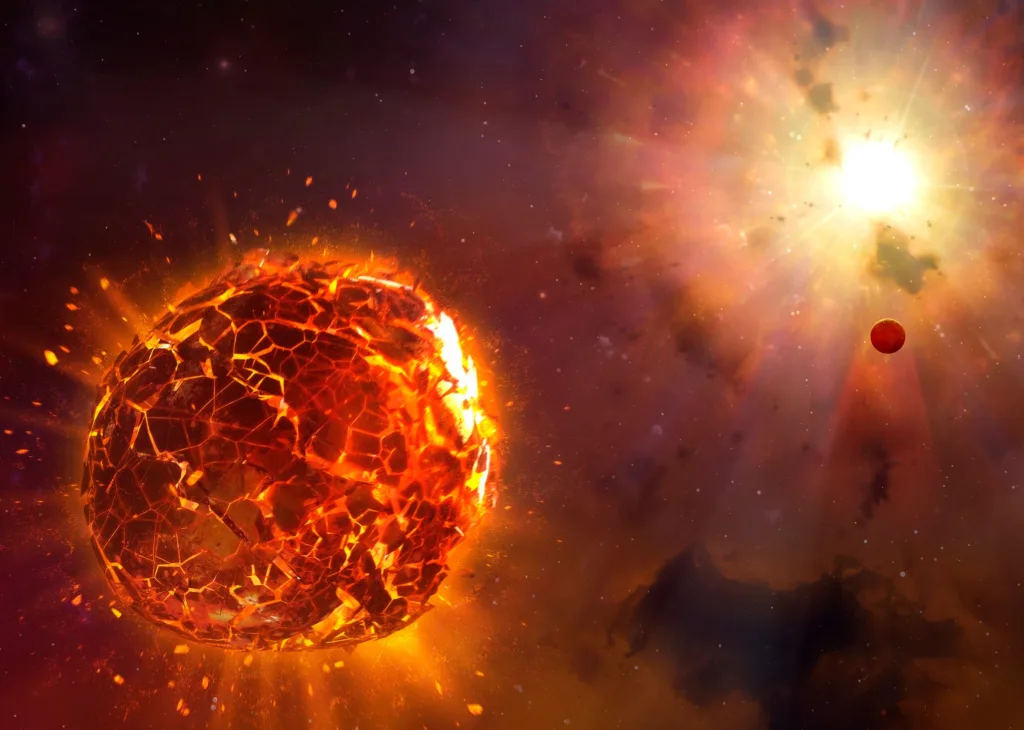Betelgeuse is a bright red supergiant star located in our galaxy that is nearing the end of its life. This massive star is approximately 650 light years away from Earth, wich means it takes light 650 years to reach us from Betelgeuse.
Astrophysicists predict that Betelgeuse will eventually explode as a supernova, which could potentially be visible in the daytime sky. However, we do not need to worry about this event harming or destroying life on Earth. The explosion would have to occur within 50 light-years of our planet to cause any harm, and Betelgeuse is nearly 10 times that distance away.
The distance between Earth and Betelgeuse is so vast that it would take our fastest spacecraft approximately 12,800,000 years to reach the star. This distance offers some relief to those who worry about the possibility of Betelgeuse exploding in the future.
Betelgeuse is a massive red supergiant star located approximately 650 light years away from Earth. While it is expected to eventually explode as a supernova, this event poses no threat to life on our planet due to the vast distance between us and the star. As we continue to study and learn about the universe, Betelgeuse remains a fascinating and important celestial object to observe and understand.
Estimating the Time Required to Reach Betelgeuse
Betelgeuse is a red supergiant star located in the constellation of Orion and is approximately 650 light years away from Earth. With our current technology, it is not possible to travel to Betelgeuse in a reasonable amount of time.
To put the distance into perspective, one light year is equivalent to the distance that light can travel in one year, which is roughly 5.88 trillion miles (9.46 trillion kilometers). This means that Betelgeuse is approximately 3,810,000,000,000,000 miles (6,148,000,000,000,000 kilometers) away from us.
If we were to travel to Betelgeuse at the speed of light, which is the fastest speed possible, it would take us 650 years to reach the star. However, it is impossible to travel at this speed due to the laws of physics.
Currently, the fastest spacecraft ever launched by humans is the Parker Solar Probe, which can travel at speeds of up to 430,000 miles per hour (690,000 kilometers per hour). At this speed, it would take the Parker Solar Probe approximately 17 million years to reach Betelgeuse, which is clearly not a feasible option.
Therefore, it is unlikely that humans will ever be able to physically travel to Betelgeuse, but we can continue to study and learn abut this fascinating star from afar using telescopes and other instruments.

Source: eso.org
Estimated Remaining Time for Betelgeuse
Betelgeuse, a red supergiant star in the constellation of Orion, is one of the largest and brightest stars in our galaxy. However, its fate is sealed, and it will eventually explode as a supernova, marking the end of its life. The question on everyone’s mind is, how long does Betelgeuse have left?
The short answer is that Betelgeuse coud go supernova at any time, but scientists estimate that it will happen within the next 100,000 years. This may seem like a long time, but in astronomical terms, it’s just a blink of an eye.
Betelgeuse has been exhibiting signs of instability for years, with its brightness fluctuating and its shape changing. These changes are signs that the star is nearing the end of its life and getting ready to explode.
When Betelgeuse does go supernova, it will be an incredible sight to behold. It will likely be visible in the daytime and shine brighter than any other star in the sky. The explosion will release an enormous amount of energy and create a neutron star or black hole.
While we can’t predict exactly when Betelgeuse will go supernova, scientists estimate that it will happen within the next 100,000 years. When it does, it will be a spectacular event that will be visible to everyone on Earth.
The Possibility of Surviving Betelgeuse’s Explosion
Betelgeuse, a red supergiant star located in the constellation Orion, has been in the news recently due to concerns about its potential supernova explosion. There have been questions about whether such an event would be harmful to life on Earth.
The answer is that we can survive Betelgeuse’s explosion. Astrophysicists have stated that Earth is too far away from Betelgeuse for the explosion to cause any harm or destruction to life on our planet. According to studies, we would need to be within 50 light-years of a supernova for it to cause any harm to Earth. Betelgeuse is almost 10 times this distance from us, making it safe for us.
It is important to note that while Betelgeuse’s potential supernova explosion poses no threat to us, it will undoubtedly be a fascinating astronomical event to observe. The explosion of Betelgeuse could beome one of the brightest objects in the night sky, visible even during the day for several weeks.
Betelgeuse’s potential supernova explosion will not harm or destroy life on Earth, as we are too far away from the star. However, it will be a remarkable event to witness and study for astronomers, and it’s exciting to think about what we may learn from it.
Exploring the Possibility of Reaching Betelgeuse
Betelgeuse is a red supergiant star located in the Orion constellation. It is one of the largest known stars and is estimated to be abut 640 light-years away from Earth. Due to its distance, it is not currently possible for humans to reach Betelgeuse with our current technology.
Assuming that our fastest spacecraft can travel at about one light-year per 20,000 years, it would take us approximately 12,800,000 years to reach Betelgeuse. This distance is far beyond the capabilities of any current spacecraft or technology.
However, it is important to note that Betelgeuse is a variable star, meaning that its brightness and size can change over time. There has been speculation that Betelgeuse may go supernova in the future, which could potentially have significant effects on Earth. However, it is important to note that the exact timing and effects of a Betelgeuse supernova are uncertain and difficult to predict.
While Betelgeuse is a fascinating object in the universe, it is currently beyond our reach. However, continued advancements in technology could potentially make it possible to explore this distant star in the future.

Conclusion
Betelgeuse is a fascinating star that has captured the attention of astronomers and stargazers alike. With its bright red color and massive size, it is one of the most easily recognizable stars in the sky. However, Betelgeuse’s life is coming to an end, and it is expected to explode as a supernova sometime in the next 100,000 years. While this explosion will be a spectacular sight, it poses no danger to life on Earth due to the star’s distance from our planet. Even if we were able to travel to Betelgeuse, it wold take millions of years to reach it, providing a sense of relief to those who worry about the star’s future. Betelgeuse is a reminder of the beauty and complexity of the universe, and studying it can help us better understand the processes that shape the cosmos.
